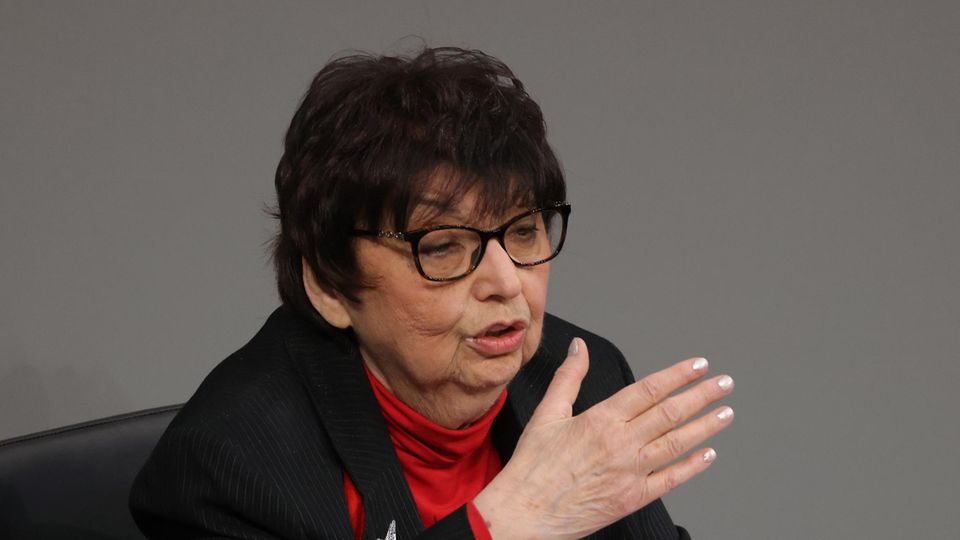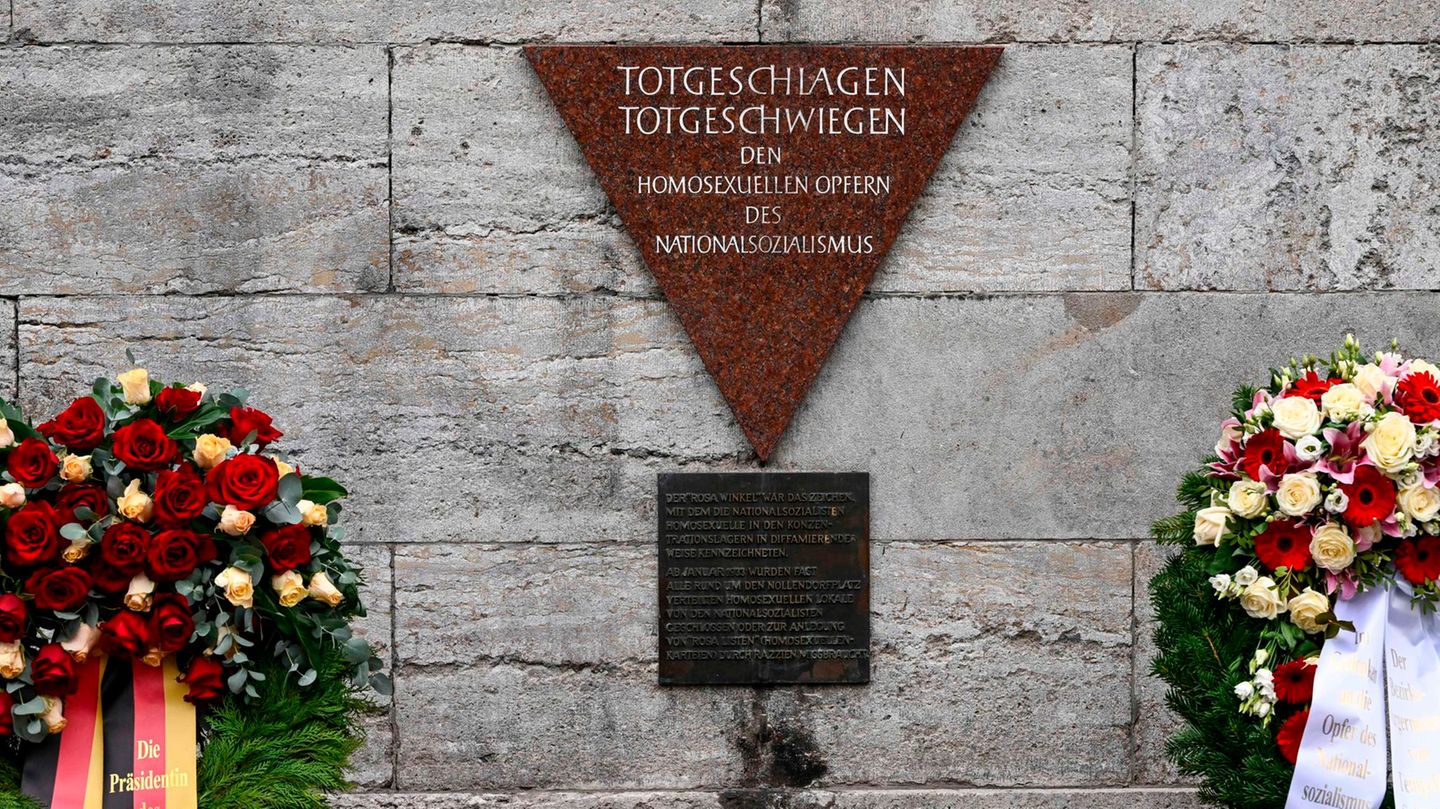The Bundestag commemorates the people who were murdered and persecuted during the National Socialist era. This year, the queer victims of the Nazi regime will be commemorated for the first time.
In Germany, January 27th is a day to commemorate the victims of National Socialism. On this day in 1945, Red Army soldiers had liberated the survivors of the German concentration camp at Auschwitz in occupied Poland. More than a million people were murdered, mostly Jews.
This day has been a day of remembrance in Germany since 1996.
This year, for the first time, the Bundestag is commemorating the victims of the National Socialist persecution of members of sexual minorities. Gay men, but also lesbian women and transsexuals were tortured in prison and in concentration camps. The criminal law paragraph 175 served the Nazis as legitimation, later they tightened it drastically.
The history of the queer victims of National Socialism has long been disregarded in research, processing and remembrance. “They were not considered ‘worthy’ victims, not even victims”said the federal government’s queer commissioner, Sven Lehmann (Greens). “The hour of remembrance in the Bundestag ends a painful ignorance of the suffering suffered for far too long and brings the queer victims into the collective memory.”
Paragraph 175 dates from the imperial era
Paragraph 175 was established on May 15, 1871, still in the days of the German Empire. He forbade “unnatural fornication” between men, she was punished with imprisonment. Also the “civil rights” could be withdrawn.
In the years that followed, there were efforts to defuse the paragraph and even to delete it entirely. In October 1921 – in the Weimar Republic – the SPD politician and Reich Minister of Justice Gustav Radebruch wanted the “simple homosexuality” keep unpunished. However, his proposal was not processed by the government.
The time of the Weimar Republic, the time between the world wars, was comparatively more open. The capital Berlin was considered a magnet for queer people because you could move around more anonymously there. Even before the First World War there are said to have been bars for homosexuals. That was popular “Eldorado”.
In the “capital of homosexuals” since the 19th century there was also the world’s first gay organization, the “Scientific Humanitarian Committee” by the Jewish doctor and sex researcher Magnus Hirschfeld. He campaigned against the stigmatization of queer people and spread the view that they were not sick.
Still, there have been attacks on queer people; many of them hid their identities in public.
National Socialism: Homosexuals persecuted and deported to concentration camps
In October 1929, the criminal law committee of the Reichstag recommended by a narrow majority that the “simple homosexuality” among adults. However, the crisis in the early 1930s and the strengthening of the National Socialists prevented its implementation.
When the Nazis seized power in 1933, the situation for queer people deteriorated massively. In February of the same year, NSDAP Interior Minister Hermann Göring ordered bars to be closed “which serve as traffic places for circles that worship unnatural fornication”. There were raids, magazines and books were banned and publishers were closed. A few weeks later, the first homosexual men were deported to concentration camps (KZ).
The aim of the National Socialists: The “weakening of the general power of the people”i.e. the population.
There were lists “of all persons who have engaged in homosexual activity in any way”, prepared. There were further raids and arrests of homosexuals who “degenerate” or “folk pests” were insulted. If queer people were also of Jewish faith, persecution was even more likely.
July 20, 1944
Ten important audio books on the resistance against Nazi terror
In 1935, with the significant tightening of Paragraph 175, the Reich Center for Combating Homosexuality and Abortion was founded. Not only gay sex was punishable from now on. Even a letter, a look, or a smile could be considered “lustful intent of the perpetrator” be interpreted and punished. During the Nazi era, about 50,000 judgments were due “fornication” liked among men.
The death rate of homosexual concentration camp prisoners was 60 percent
But she became gay “voluntary” castration allowed. Many homosexuals saw it as the only way to escape imprisonment and concentration camps. It was therefore difficult to speak of voluntariness. From 1942, forced castration was allowed in the concentration camps.
In 1940, Heinrich Himmler, Reichsfuhrer SS, ordered that all convicted under paragraph 175 in “police preventive detention” are to be taken. In plain language this means: concentration camps. The men who were abducted there had to “pink angle” wear a mark of identification. From 1941 even the death penalty could be imposed on homosexual men.
It is estimated that between 10,000 and 15,000 men were imprisoned in concentration camps for being homosexual. Hard work, harassment by the security guards and medical experiments were part of everyday life there. The death rate of homosexual concentration camp prisoners was 60 percent.
Homosexual women were less persecuted than gay men. In the eyes of the National Socialists they were less threatening. Female homosexuality was only in the later “connected” Austria punishable. But even if they went unpunished, lesbian women were subjected to repression, especially when they were in conflict with the Nazi regime.

In 2002 homosexual victims of the Nazi regime were rehabilitated
Even today, the situation of queer women during the Nazi era has not been researched very much, as there was no separate category for lesbian concentration camp prisoners. Researchers also debate whether Section 175 only applied to men or also to women. However, some cases of women should prove that “whose imprisonment in the concentration camps being a lesbian could have played a causal role”.
For a long time, the homosexual victims of the Nazi regime were ignored or even acknowledged. They were only rehabilitated by the Bundestag in 2002.
This injustice was at best a taboo niche topic in the coming to terms with the past decades. Only in recent years has historical research taken on the subject and clearly identified gay, lesbian and other queer people as victims of National Socialist injustice.
After the end of the Nazi era, the persecution continued
Since 2018, the Bundestag has had a petition calling for the queer victims of National Socialism to be honored. Former Bundestag President Wolfgang Schäuble (CDU) did not want to take up the suggestion. This changed with his successor Bärbel Bas (SPD).
“It is very important to me that today we commemorate the people who were persecuted because of their sexual orientation and gender identity”, she said in her commemorative speech in the Bundestag. Bas recalled “the many thousands of women and men who were deported to concentration camps because of their sexuality – sometimes under pretexts”.
In her speech, she also addressed the continuation of injustice and discrimination after the end of National Socialism.
With the end of the Second World War and the Nazi regime, the terror against homosexuals ended. But Paragraph 175 remained in force, both in the Federal Republic and in the GDR. Some of the freed homosexual concentration camp inmates even had to complete their remaining sentences in normal prisons.
Paragraph 175 is only deleted in 1994
In the newly founded Federal Republic, so-called “pink lists” continued with the names of homosexuals; Convictions from the Nazi era were still legal in the early years of the republic. In 1950 it even happened in the Federal Republic “Action against homosexuals”, in which about 100 people were arrested and 75 charges were brought. 45,000 people were sentenced in the first 15 years of the Federal Republic for violating paragraph 175.
Only in 1969 did something happen in West Germany – a consequence of the 1968 movement, the time of the sexual revolution. From that point on, homosexuality among adult men over the age of 21 was exempt from punishment. Four years later the age was lowered to 18; the so-called age of consent for heterosexual acts was 14 years. Paragraph 175 was still applied in the Federal Republic of Germany until the 1990s.
Homosexuals were also persecuted in the GDR, albeit to a lesser extent than in West Germany. Paragraph 175 existed until 1968, which was then replaced by Paragraph 151. This allowed homosexuality between men and women. Sexual acts by homosexual men and women with minors remained punishable. In 1988, paragraph 151 was completely removed and the age of consent was adjusted. Nevertheless, spying and reprisals were part of everyday life for homosexuals in the GDR.
With the reunification and the merger of the legal systems of the two German states, paragraph 175 is finally deleted in March 1994.
Today, monuments in Germany commemorate the persecution of homosexuals. Like that “Frankfurt angel” or the memorial for homosexuals persecuted under National Socialism in Berlin.
Sources: , , , , , , , , ,
Source: Stern
I have been working in the news industry for over 6 years, first as a reporter and now as an editor. I have covered politics extensively, and my work has appeared in major newspapers and online news outlets around the world. In addition to my writing, I also contribute regularly to 24 Hours World.




